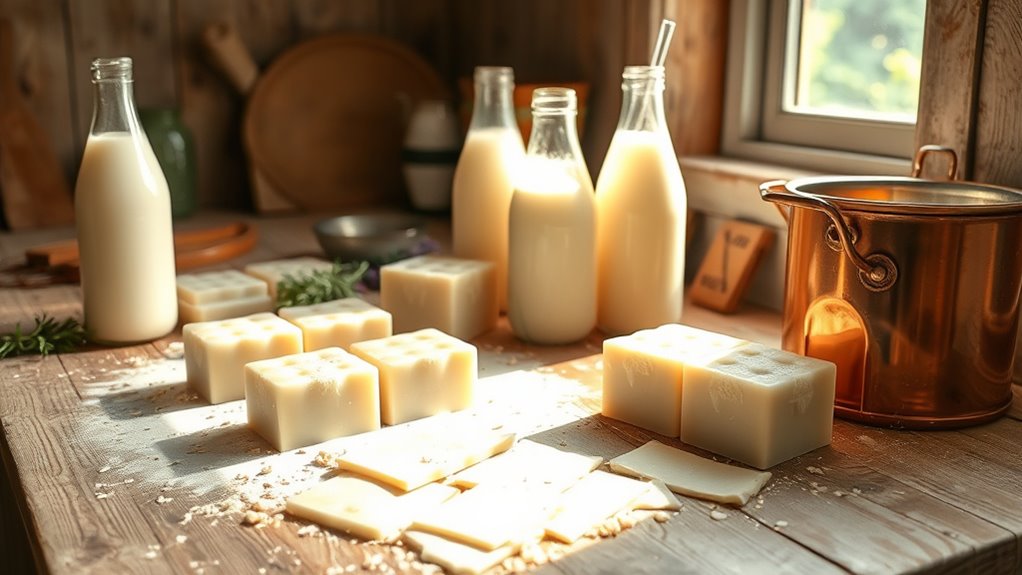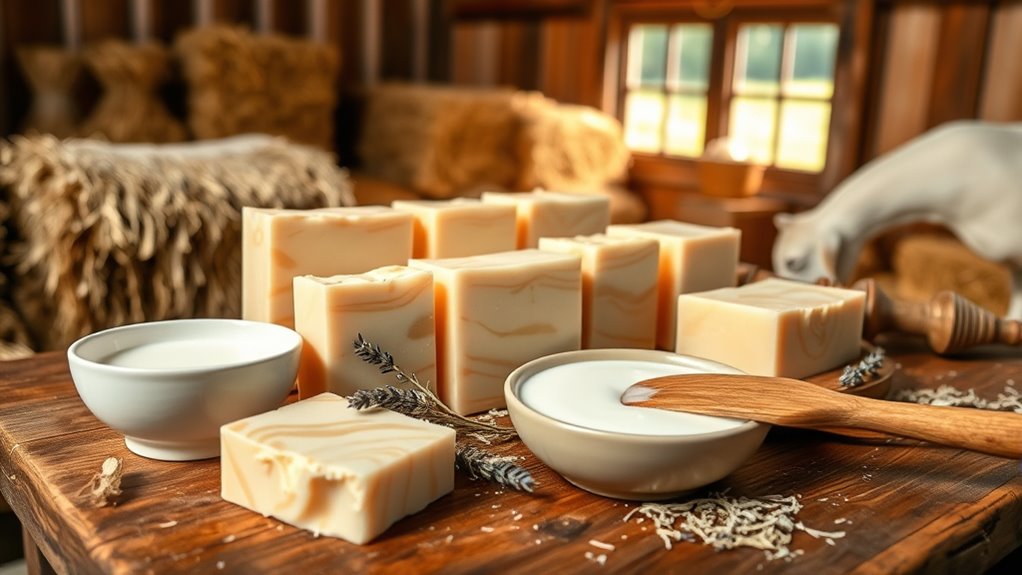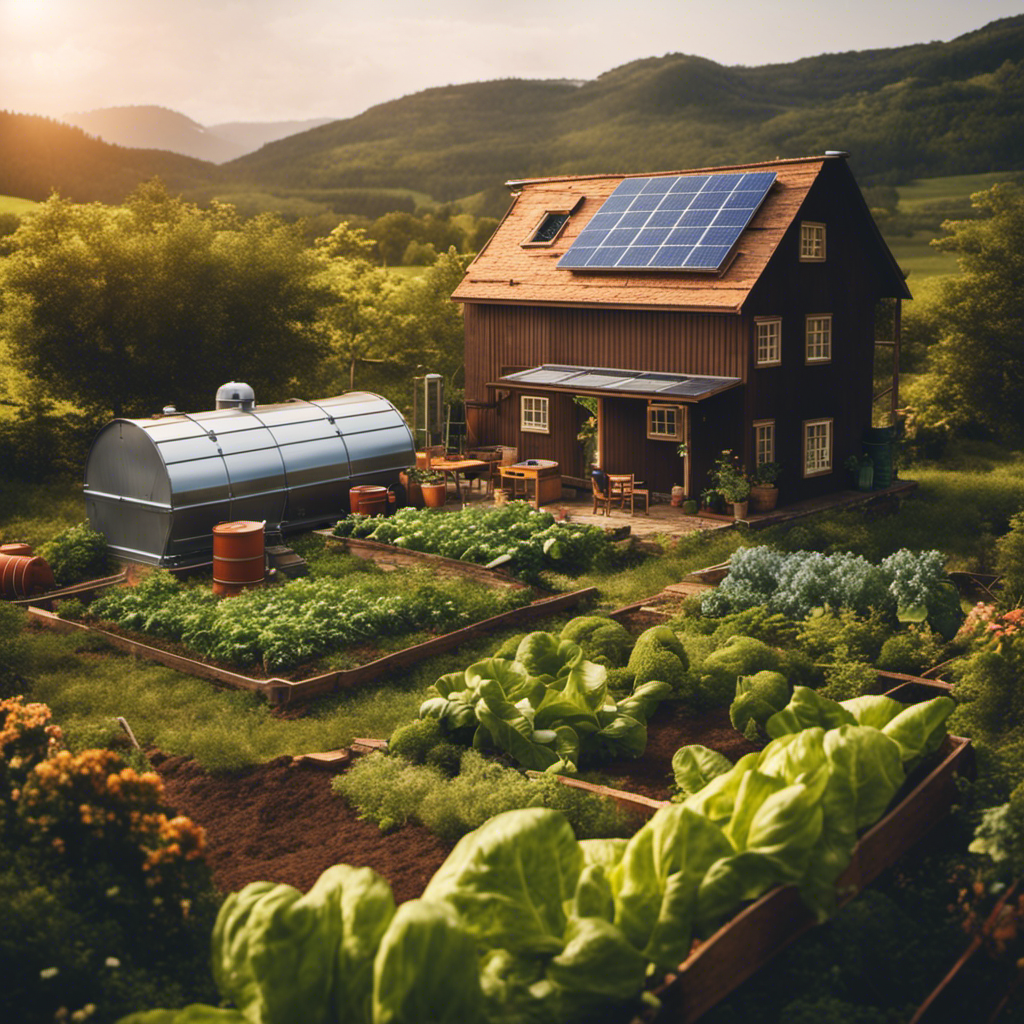Making soap with goat milk from your own herd lets you create natural, nourishing skincare products that add a gentle, silky feel. Proper herd management guarantees high-quality milk rich in vitamins and healthy fats, which enhance your soap’s texture and aroma. Using fresh, well-maintained milk during soapmaking helps maintain nutrients and prevents curdling. If you keep these tips in mind, you’ll discover more ways to craft luxurious, skin-friendly soap from your own goats.
Key Takeaways
- Use fresh, properly stored goat milk, ideally freeze it before adding to soap to prevent scorching and preserve nutrients.
- Incorporate milk during cold process or melt-and-pour stages for optimal integration and soap quality.
- Maintain herd health through regular checks and proper nutrition to ensure high-quality, contaminant-free milk for soapmaking.
- Use AI-driven herd management to monitor health, optimize milk production, and ensure consistent raw materials.
- Incorporate milk early in the process to create a gentle, moisturizing, and luxurious soap suitable for sensitive skin.

If you have your own herd of goats, making soap with fresh goat milk is a rewarding way to utilize their milk while creating a luxurious, natural product. Not only do you get the satisfaction of crafting something handmade, but you also tap into the many goat milk benefits that make your soap stand out. Goat milk is rich in vitamins A, D, and E, as well as essential fatty acids, which help nourish and hydrate the skin. Using fresh milk directly from your goats preserves these nutrients, resulting in a soap that’s gentle and moisturizing, perfect for sensitive or dry skin.
However, to fully enjoy these benefits, you need to maintain excellent herd health management. Healthy goats produce higher-quality milk, which translates into better soap. Regular health checks, proper nutrition, and parasite control are essential to keep your herd thriving. When your goats are healthy, their milk contains fewer contaminants and bacteria, making it safer and more effective for soapmaking. Additionally, a well-managed herd reduces the risk of mastitis or other infections that could compromise milk quality. Managing your herd’s health also ensures consistent milk production, so you can plan your soap batches with confidence, knowing you’re using the best possible raw material.
Incorporating fresh goat milk into soapmaking is straightforward. You typically add it during the cold process or melt-and-pour stages, depending on your method. When adding milk to soap, it’s best to freeze it beforehand to prevent it from scorching or curdling when mixed with lye. This step helps retain the milk’s nutrients and creates a creamy, smooth soap. As you mix, you’ll notice the milk contributes to a rich, silky lather, and the natural fats in the milk help produce a soap that’s gentle on the skin. The aroma and texture of your soap will also be enhanced by the fresh milk, giving it a subtle, natural scent and a luxurious feel. Moreover, AI-driven solutions are increasingly being used to optimize herd management and improve milk quality, ensuring your soap remains top-notch.
Frequently Asked Questions
How Do I Properly Store Fresh Goat Milk for Soapmaking?
To properly store fresh goat milk for soapmaking, focus on milk preservation by keeping it at a consistent, cold temperature, ideally below 40°F (4°C). Use clean, airtight storage containers to prevent contamination and spoilage. If you’re not using the milk immediately, consider freezing it in small portions. This helps maintain freshness and quality, ensuring your soap turns out smoothly with the nourishing benefits of fresh goat milk.
Can I Substitute Goat Milk With Plant-Based Alternatives?
You can definitely substitute goat milk with plant-based alternatives in soapmaking. Plant-based options like almond milk, coconut milk, or oat milk work as soap ingredient substitutions, offering different benefits and lather qualities. Keep in mind, these alternatives may alter the soap’s texture, scent, and moisturizing properties. Experimenting with small batches helps you understand how each plant-based milk impacts your final product, ensuring you get the desired results.
What Are Common Mistakes to Avoid When Using Goat Milk?
You might think using goat milk is foolproof, but don’t forget milk spoilage and bacterial contamination are sneaky foes. Avoid pouring it straight into your soap without proper handling, as bacteria can thrive, ruining your batch. Always sterilize your equipment, keep milk refrigerated, and use it promptly. Ignoring these simple steps can turn your soap into a breeding ground for unwanted microbes, despite your best efforts.
How Does Goat Milk Affect the Soap’S Shelf Life?
Goat milk can affect your soap’s shelf life because milk oxidation speeds up spoilage, and enzyme activity may cause deterioration over time. You might notice faster rancidity or changes in scent and color if you don’t store your soap properly. To extend shelf life, keep your soap cool, dry, and away from direct sunlight. Proper storage minimizes milk oxidation and enzyme activity, helping your soap stay fresh longer.
Are There Specific Safety Precautions for Handling Raw Goat Milk?
Oh, handling raw goat milk? Just ignore milk contamination risks and skip cleaning your handling equipment? Of course not! You’ve got to be vigilant. Always sterilize your handling equipment thoroughly and keep raw milk refrigerated. Wash your hands, avoid cross-contamination, and use fresh milk. These precautions keep your soap safe and prevent unwanted bacteria. Treat raw goat milk like the treasure it is—cleanliness is key!
Conclusion
Now that you’ve learned how to craft soap using milk from your own herd, you can enjoy the satisfaction of creating something truly special and nourishing. Isn’t there something uniquely rewarding about turning your farm’s bounty into a luxurious, natural soap? With a little practice, you’ll find yourself producing beautiful, gentle bars that benefit your skin and connect you even deeper to your farm life. So, why not start your soapmaking journey today and embrace this fulfilling craft?










